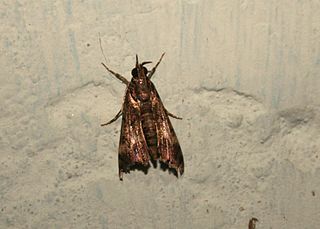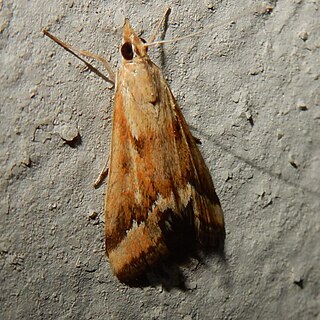
Conogethes is a genus of moths in the subfamily Spilomelinae of the family Crambidae. The currently 17 recognized species are distributed in the Indomalayan and Australasian realm.

Notarcha is a genus of moths in the family Crambidae described by Edward Meyrick in 1884.
Chalestra is a monotypic moth genus of the family Erebidae. Its only species, Chalestra podaresalis, is found in South Africa. Both the genus and species were first described by Francis Walker in 1859.

Meliaba is a monotypic moth genus of the family Erebidae. Its only species, Meliaba pelopsalis, is known from South Africa, Eswatini, Tanzania and Zimbabwe. Both the genus and the species were first described by Francis Walker in 1859.

Glyphodes negatalis, the karanj defoliator, is a moth of the family Crambidae. The species was first described by Francis Walker in 1859. It has a wide range in the tropics, including South Africa, The Gambia, Mali, India, Sri Lanka, Hong Kong, Japan, and eastern Australia.

Bradina admixtalis is a species of moth of the family Crambidae described by Francis Walker in 1859. It is found in Australia, New Guinea, New Zealand, south-east Asia and the Comoros, Réunion, South Africa as well as India.

Orphanostigma abruptalis is a moth of the family Crambidae. The species was first described by Francis Walker in 1859. It occurs in the tropics of the Old World from Africa to Australia.

Noorda blitealis is a species of moth of the family Crambidae. It is found in subtropical Africa, south of the Sahara and in Australasia.

Achyra coelatalis is a species of moth in the family Crambidae. It was described by Francis Walker in 1859. It is found in Botswana, the Democratic Republic of the Congo, Ghana, Kenya, Réunion, Lesotho, Madagascar, Namibia, Niger, the Seychelles, South Africa, Tanzania, Zambia, Zimbabwe, Australia, India and Sri Lanka.

Glyphodes pyloalis, the lesser mulberry snout moth, lesser mulberry pyralid or beautiful glyphodes moth, is a moth in the family Crambidae. It was described by Francis Walker in 1859. It is found in Iran, China, Japan, India, Indonesia (Sumatra), Sri Lanka, Taiwan, the Democratic Republic of the Congo, Equatorial Guinea, Mozambique and North America, where it has been recorded from Florida, Maryland, North Carolina, South Carolina and Virginia.
Herpetogramma stultalis is a moth in the family Crambidae. It was described by Francis Walker in 1859. It is found in Malaysia, India, Sri Lanka, China, Japan, Pakistan, Papua New Guinea and Australia, where it has been recorded from Queensland. In Africa, it has been recorded from the Democratic Republic of the Congo and Réunion.
Notarcha viettalis is a moth in the family Crambidae. It was described by Hubert Marion in 1956. It is found on Madagascar.
Notarcha cassusalis is a moth in the family Crambidae. It was described by Francis Walker in 1859. It is found in South Africa and the Gambia.
Notarcha digitalis is a moth in the family Crambidae. It was described by Jay C. Shaffer and Eugene G. Munroe in 2007. It is found on the Seychelles, where it has been recorded from Aldabra.
Omiodes poeonalis is a moth in the family Crambidae. It was described by Francis Walker in 1859. It is found in the Democratic Republic of the Congo, Sierra Leone, Tanzania, the Chagos Archipelago, China, Indonesia, Sri Lanka, Japan and Australia (Queensland).

Patania sabinusalis is a moth in the family Crambidae. It was described by Francis Walker in 1859. It is found in Australia, Cameroon, the Democratic Republic of the Congo, Kenya, the Seychelles, Somalia, Uganda, Zambia, Sri Lanka, India, Borneo, Java, Fiji, New Guinea, Samoa, the Solomon Islands, Taiwan and Japan.









